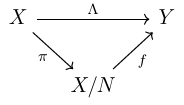The completeness of the quotient space (topological vector space)
The Goal
We are going to show the completeness of $X/N$ where $X$ is a TVS and $N$ a closed subspace. Alongside, a bunch of useful analysis tricks will be demonstrated (and that’s why you may find this blog post a little tedious.). But what’s more important, the theorem proved here will be used in the future.
The main process
To make it clear, we should give a formal definition of $F$-space.
A topological space $X$ is an $F$-space if its topology $\tau$ is induced by a complete invariant metric $d$.
A metric $d$ on a vector space $X$ will be called invariant if for all $x,y,z \in X$, we have
By complete we mean every Cauchy sequence of $(X,d)$ converges.
Defining the quotient metric $\rho$
The metric can be inherited to the quotient space naturally (we will use this fact latter), that is
If $X$ is a $F$-space, $N$ is a closed subspace of a topological vector space $X$, then $X/N$ is still a $F$-space.
Suppose $d$ is a complete invariant metric compatible with $\tau_X$. The metric on $X/N$ is defined by
$\rho$ is a metric
Proof. First, if $\pi(x)=\pi(y)$, that is, $x-y \in N$, we see
If $\pi(x) \neq \pi(y)$ however, we shall show that $\rho(\pi(x),\pi(y))>0$. In this case, we have $x-y \notin N$. Since $N$ is closed, $N^c$ is open, and $x-y$ is an interior point of $X-N$. Therefore there exists an open ball $B_r(x-y)$ centered at $x-y$ with radius $r>0$ such that $B_r(x-y) \cap N = \varnothing$. Notice we have $d(x-y,z)>r$ since otherwise $z \in B_r(x-y)$. By putting
we see $d(x-y,z) \geq r_0$ for all $z \in N$ and indeed $r_0=\inf_{z \in N}d(x-y,z)>0$ (the verification can be done by contradiction). In general, $\inf_z d(x-y,z)=0$ if and only if $x-y \in \overline{N}$.
Next, we shall show that $\rho(\pi(x),\pi(y))=\rho(\pi(y),\pi(x))$, and it suffices to assume that $\pi(x) \neq \pi(y)$. Sgince $d$ is translate invariant, we get
Therefore the $\inf$ of the left hand is equal to the one of the right hand. The identity is proved.
Finally, we need to verify the triangle inequality. Let $r,s,t \in X$. For any $\varepsilon>0$, there exist some $z_\varepsilon$ and $z_\varepsilon’$ such that
Since $d$ is invariant, we see
(I owe @LeechLattice for the inequality above.)
Therefore
(Warning: This does not imply that $\rho(\pi(r),\pi(s))+\rho(\pi(s),\pi(t))=\inf_z d(r-t,z)$ since we don’t know whether it is the lower bound or not.)
If $\rho(\pi(r),\pi(s))+\rho(\pi(s),\pi(t))<\rho(\pi(r),\pi(t))$ however, let
then there exists some $z’’_\varepsilon=z_\varepsilon+z’_\varepsilon$ such that
which is a contradiction since $\rho(\pi(r),\pi(t)) \leq d(r-t,z)$ for all $z \in N$.
(We are using the $\varepsilon$ definition of $\inf$. See here.)
$\rho$ is translate invariant
Since $\pi$ is surjective, we see if $u \in X/N$, there exists some $a \in X$ such that $\pi(a)=u$. Therefore
$\rho$ is well-defined
If $\pi(x)=\pi(x’)$ and $\pi(y)=\pi(y’)$, we have to show that $\rho(\pi(x),\pi(y))=\rho(\pi(x’),\pi(y’))$. In fact,
since $\rho(\pi(x),\pi(x’))=0$ as $\pi(x)=\pi(x’)$. Meanwhile
therefore $\rho(\pi(x),\pi(y))=\rho(\pi(x’),\pi(y’))$.
$\rho$ is compatible with $\tau_N$
By proving this, we need to show that a set $E \subset X/N$ is open with respect to $\tau_N$ if and only if $E$ is a union of open balls. But we need to show a generalized version:
If $\mathscr{B}$ is a local base for $\tau$, then the collection $\mathscr{B}_N$, which contains all sets $\pi(V)$ where $V \in \mathscr{B}$, forms a local base for $\tau_N$.
Proof. We already know that $\pi$ is continuous, linear and open. Therefore $\pi(V)$ is open for all $V \in \mathscr{B}$. For any open set around $E \subset X/N$ containing $\pi(0)$, we see $\pi^{-1}(E)$ is open, and we have
and therefore
Now consider the local base $\mathscr{B}$ containing all open balls around $0 \in X$. Since
we see $\rho$ determines $\mathscr{B}_N$. But we have already proved that $\rho$ is invariant; hence $\mathscr{B}_N$ determines $\tau_N$.
If $d$ is complete, then $\rho$ is complete.
Once this is proved, we are able to claim that, if $X$ is a $F$-space, then $X/N$ is still a $F$-space, since its topology is induced by a complete invariant metric $\rho$.
Proof. Suppose $(x_n)$ is a Cauchy sequence in $X/N$, relative to $\rho$. There is a subsequence $(x_{n_k})$ with $\rho(x_{n_k},x_{n_{k+1}})<2^{-k}$. Since $\pi$ is surjective, we are able to pick some $z_k \in X$ such that $\pi(z_k) = x_{n_k}$ and such that
(The existence can be verified by contradiction still.) By the inequality above, we see $(z_k)$ is Cauchy (can you see why?). Since $X$ is complete, $z_k \to z$ for some $z \in X$. By the continuity of $\pi$, we also see $x_{n_k} \to \pi(z)$ as $k \to \infty$. Therefore $(x_{n_k})$ converges. Hence $(x_n)$ converges since it has a convergent subsequence. $\rho$ is complete.
Remarks
This fact will be used to prove some corollaries in the open mapping theorem. For instance, for any continuous linear map $\Lambda:X \to Y$, we see $\ker(\Lambda)$ is closed, therefore if $X$ is a $F$-space, then $X/\ker(\Lambda)$ is a $F$-space as well. We will show in the future that $X/\ker(\Lambda)$ and $\Lambda(X)$ are homeomorphic if $\Lambda(X)$ is of the second category.
There are more properties that can be inherited by $X/N$ from $X$. For example, normability, metrizability, local convexity. In particular, if $X$ is Banach, then $X/N$ is Banach as well. To do this, it suffices to define the quotient norm by

